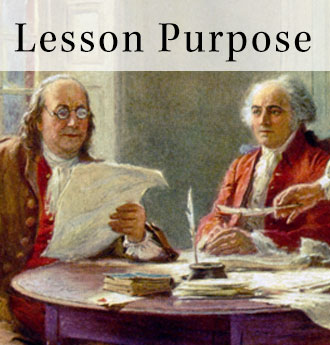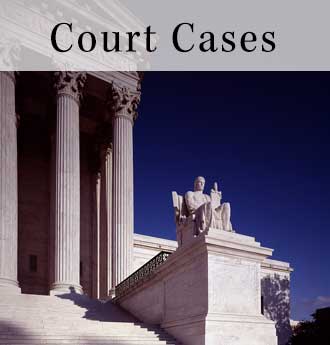Lesson 25: What Is the Role of the Supreme Court in the American Constitutional System?
The case summaries below were provided by Oyez and licensed under the Creative Commons Attribution-NonCommercial 4.0 International License. Please visit Oyez.org for more case summaries.
Luther v. Borden (1849)
Facts of the case:
In 1841, Rhode Island was still operating under an archaic system of government established by a royal charter of 1663. The charter strictly limited suffrage and made no provision for amendment. Dissident groups, protesting the charter, held a popular convention to draft a new constitution and to elect a governor. The old charter government declared martial law and put down the rebellion, although no federal troops were sent. One of the insurgents, Martin Luther, brought suit claiming the old government was not "a republican form of government" and all its acts were thereby invalid.
Case Question:
Did the Court have the constitutional authority to declare which group constituted the official government of Rhode Island?
Case Conclusion:
No. The Court held that "the power of determining that a state government has been lawfully established" did not belong to federal courts, and that it was not the function of such courts to prescribe the qualifications for voting in the states. The Court held that the creation of republican forms of government and the control of domestic violence were matters of an essentially political nature committed by the Constitution to the other branches of government. Hence, the Court should defer to Congress and the president when confronted with such issues.
Citation:
The Oyez Project, Luther v. Borden, 48 U.S. 1 (1849)
Link to case: https://www.oyez.org/cases/1789-1850/48us1
Baker v. Carr (1962)
Facts of the case:
Charles W. Baker and other Tennessee citizens alleged that a 1901 law designed to apportion the seats for the state's general assembly was virtually ignored. Baker's suit detailed how Tennessee's reapportionment efforts ignored significant economic growth and population shifts within the state.
Case Question:
Did the Supreme Court have jurisdiction over questions of legislative apportionment?
Case Conclusion:
Yes. In an opinion which explored the nature of "political questions" and the appropriateness of Court action in them, the Court held that there were no such questions to be answered in this case and that legislative apportionment was a justiciable issue. In his opinion, Justice Brennan provided past examples in which the Court had intervened to correct constitutional violations in matters pertaining to state administration and the officers through whom state affairs are conducted. Brennan concluded that the Fourteenth Amendment equal protection issues which Baker and others raised in this case merited judicial evaluation.
Citation:
The Oyez Project, Baker v. Carr, 369 U.S. 186 (1962)
Link to case: http://oyez.org/cases/1960-1969/1960/1960_6
Bush v. Gore (2000)
Facts of the case:
Following the Supreme Court's decision in Bush v. Palm Beach County Canvassing Board, and concurrent with Vice President Al Gore's contest of the certification of Florida presidential election results, on December 8, 2000 the Florida Supreme Court ordered that the Circuit Court in Leon County tabulate by hand 9,000 contested ballots from Miami-Dade County. It also ordered that every county in Florida must immediately begin manually recounting all "under-votes" (ballots which did not indicate a vote for president) because there were enough contested ballots to place the outcome of the election in doubt. Texas Governor George Bush and his running mate, Richard Cheney, filed a request for review in the U.S. Supreme Court and sought an emergency petition for a stay of the Florida Supreme Court's decision. The U.S. Supreme Court granted review and issued the stay on December 9. It heard oral arguments two days later.
Case Question:
Did the Florida Supreme Court violate Article II, Section 1, Clause 2 of the Constitution by making new election law? Do standardless manual recounts violate the Equal Protection and Due Process Clauses?
Case Conclusion:
Noting that the Equal Protection Clause guarantees individuals that their ballots cannot be devalued by "later arbitrary and disparate treatment," the unsigned opinion issued on behalf of the entire Court held 7-2 that the Florida Supreme Court's scheme for recounting ballots was unconstitutional. Even if the recount were fair in theory, it was unfair in practice. The record suggested that different standards were applied from ballot to ballot, precinct to precinct, and county to county. Because of those and other procedural difficulties, the court held that no constitutional recount could be fashioned in the time remaining (which was short because the Florida legislature wanted to take advantage of the "safe harbor" provided by 3 U.S.C. Sec. 5). Loath to make broad precedents, the opinion limited its holding to the present case. Rehnquist (in a concurring opinion joined by Scalia and Thomas) argued that the recount scheme was also unconstitutional because the Florida Supreme Court's decision made new election law, which only the state legislature may do. Breyer and Souter (writing separately) agreed with the Court's holding that the Florida supreme court's recount scheme violated the Equal Protection Clause, but they dissented with respect to the remedy, believing that a constitutional recount could be fashioned. Time is insubstantial when constitutional rights are at stake. Ginsburg and Stevens (writing separately) argued that for reasons of federalism, the Florida supreme court's decision ought to be respected. Moreover, the Florida decision was fundamentally right; the Constitution requires that every vote be counted.
Citation:
The Oyez Project, Bush v. Gore, 531 U.S. 98 (2000)
Link to case: http://oyez.org/cases/2000-2009/2000/2000_00_949







